TOYOTA CAMRY V20 1986 Service Information
Manufacturer: TOYOTA, Model Year: 1986, Model line: CAMRY V20, Model: TOYOTA CAMRY V20 1986Pages: 2389, PDF Size: 84.44 MB
Page 871 of 2389
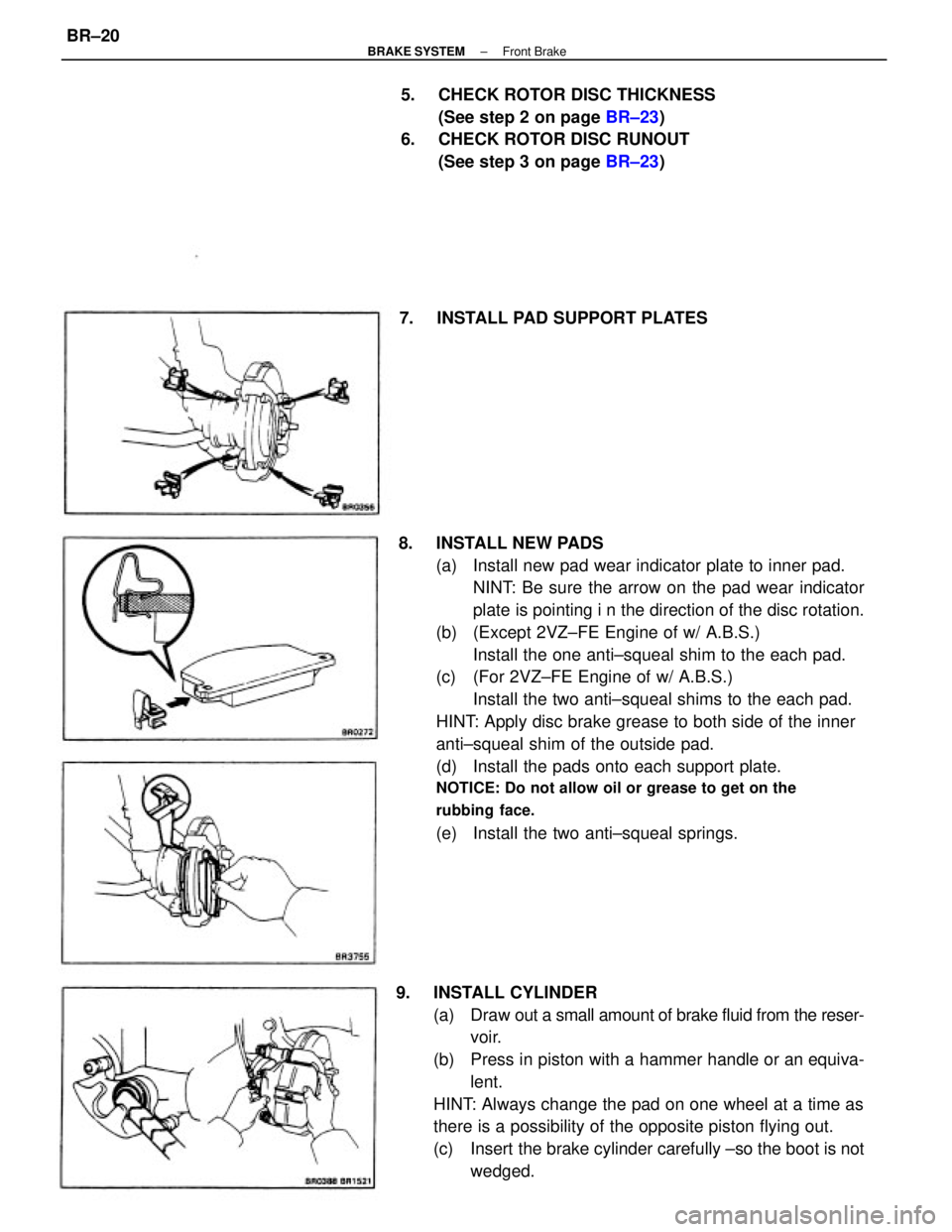
8. INSTALL NEW PADS
(a) Install new pad wear indicator plate to inner pad.
NINT: Be sure the arrow on the pad wear indicator
plate is pointing i n the direction of the disc rotation.
(b) (Except 2VZ±FE Engine of w/ A.B.S.)
Install the one anti±squeal shim to the each pad.
(c) (For 2VZ±FE Engine of w/ A.B.S.)
Install the two anti±squeal shims to the each pad.
HINT: Apply disc brake grease to both side of the inner
anti±squeal shim of the outside pad.
(d) Install the pads onto each support plate.
NOTICE: Do not allow oil or grease to get on the
rubbing face.
(e) Install the two anti±squeal springs.
9. INSTALL CYLINDER
(a) Draw out a small amount of brake fluid from the reser-
voir.
(b) Press in piston with a hammer handle or an equiva-
lent.
HINT: Always change the pad on one wheel at a time as
there is a possibility of the opposite piston flying out.
(c) Insert the brake cylinder carefully ±so the boot is not
wedged. 5. CHECK ROTOR DISC THICKNESS
(See step 2 on page BR±23)
6. CHECK ROTOR DISC RUNOUT
(See step 3 on page BR±23)
7. INSTALL PAD SUPPORT PLATES
± BRAKE SYSTEMFront BrakeBR±20
Page 872 of 2389
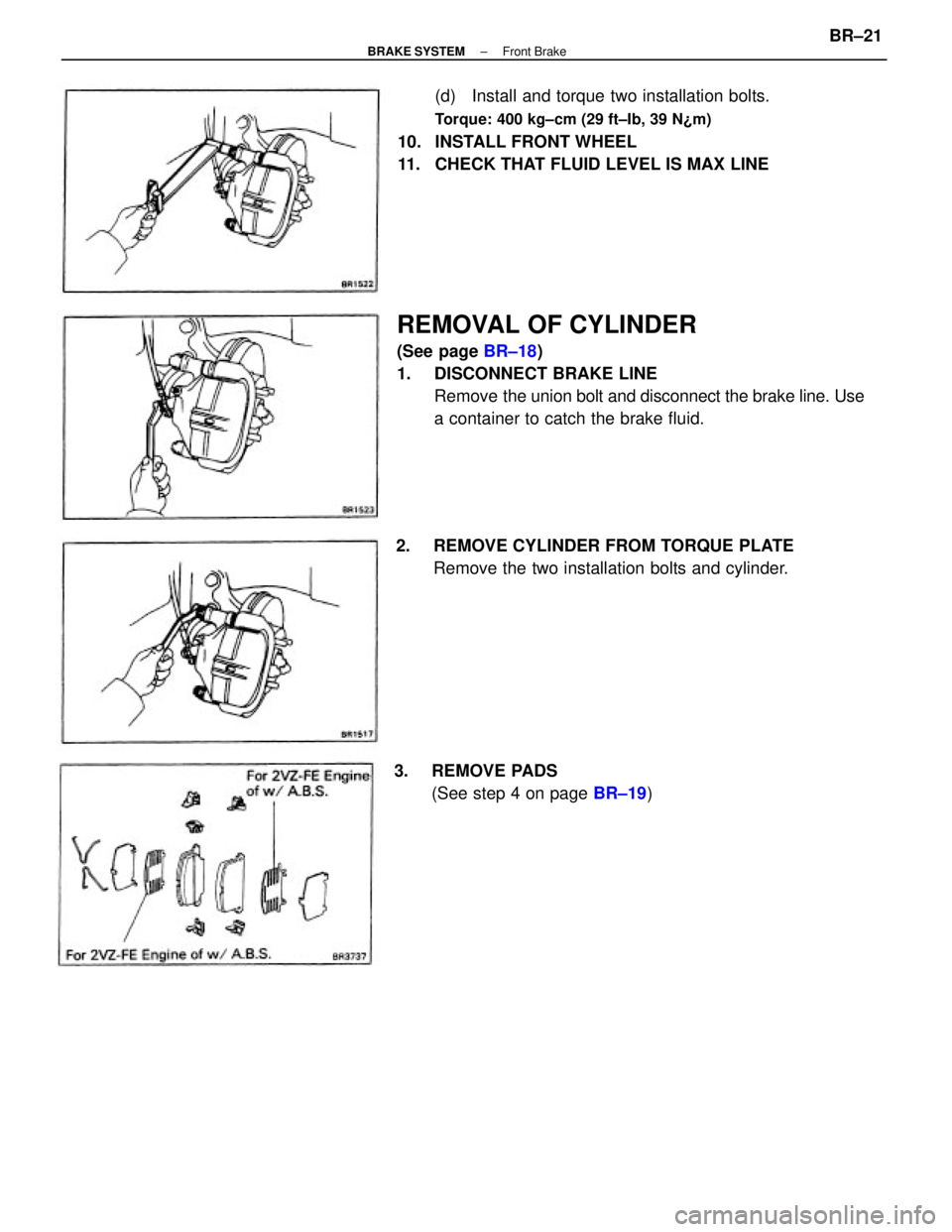
REMOVAL OF CYLINDER
(See page BR±18)
1. DISCONNECT BRAKE LINE
Remove the union bolt and disconnect the brake line. Use
a container to catch the brake fluid.(d) Install and torque two installation bolts.
Torque: 400 kg±cm (29 ft±Ib, 39 N¿m)
10. INSTALL FRONT WHEEL
11. CHECK THAT FLUID LEVEL IS MAX LINE
2. REMOVE CYLINDER FROM TORQUE PLATE
Remove the two installation bolts and cylinder.
3. REMOVE PADS
(See step 4 on page BR±19)
± BRAKE SYSTEMFront BrakeBR±21
Page 873 of 2389
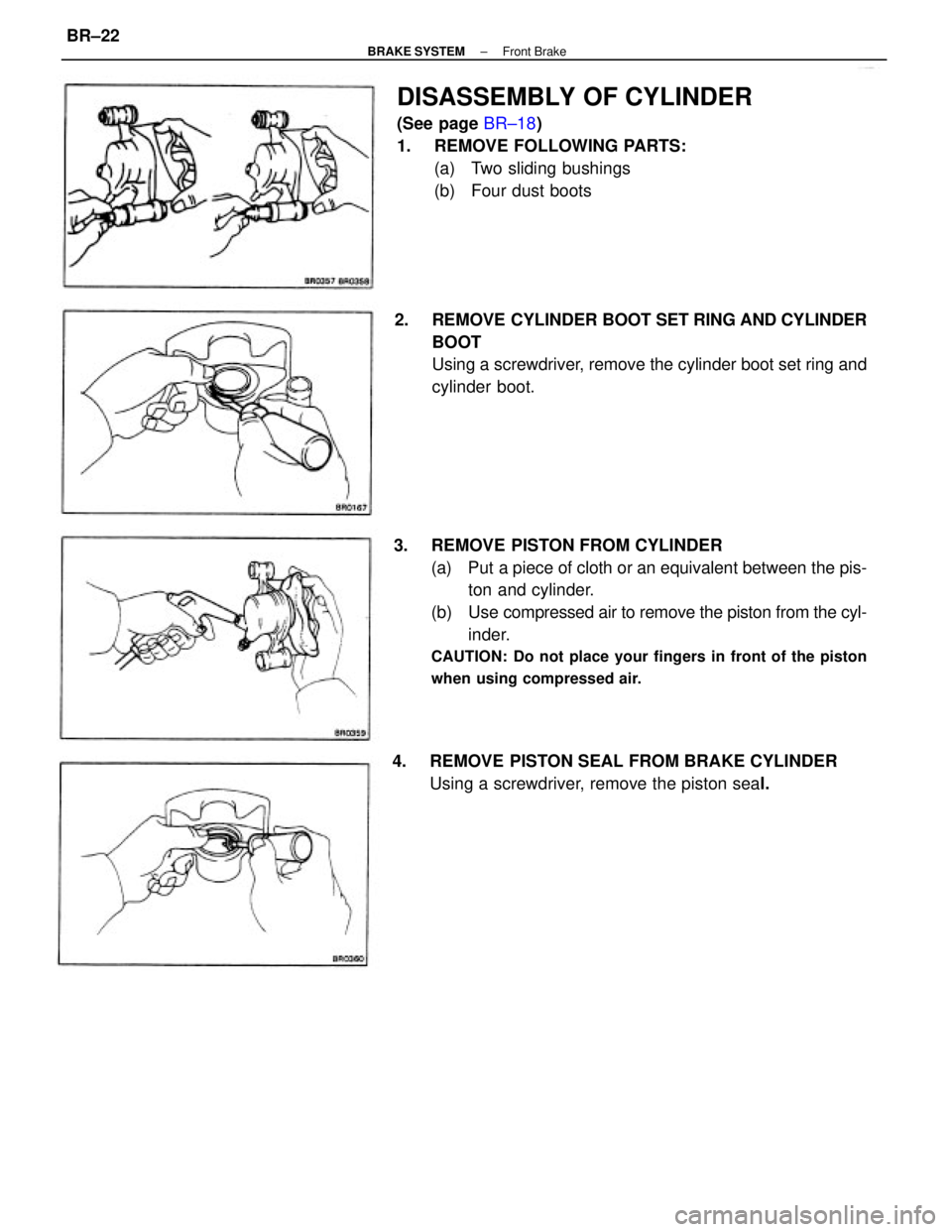
3. REMOVE PISTON FROM CYLINDER
(a) Put a piece of cloth or an equivalent between the pis-
ton and cylinder.
(b) Use compressed air to remove the piston from the cyl-
inder.
CAUTION: Do not place your fingers in front of the piston
when using compressed air.
2. REMOVE CYLINDER BOOT SET RING AND CYLINDER
BOOT
Using a screwdriver, remove the cylinder boot set ring and
cylinder boot.
DISASSEMBLY OF CYLINDER
(See page BR±18)
1. REMOVE FOLLOWING PARTS:
(a) Two sliding bushings
(b) Four dust boots
4. REMOVE PISTON SEAL FROM BRAKE CYLINDER
Using a screwdriver, remove the piston seal.
± BRAKE SYSTEMFront BrakeBR±22
Page 874 of 2389
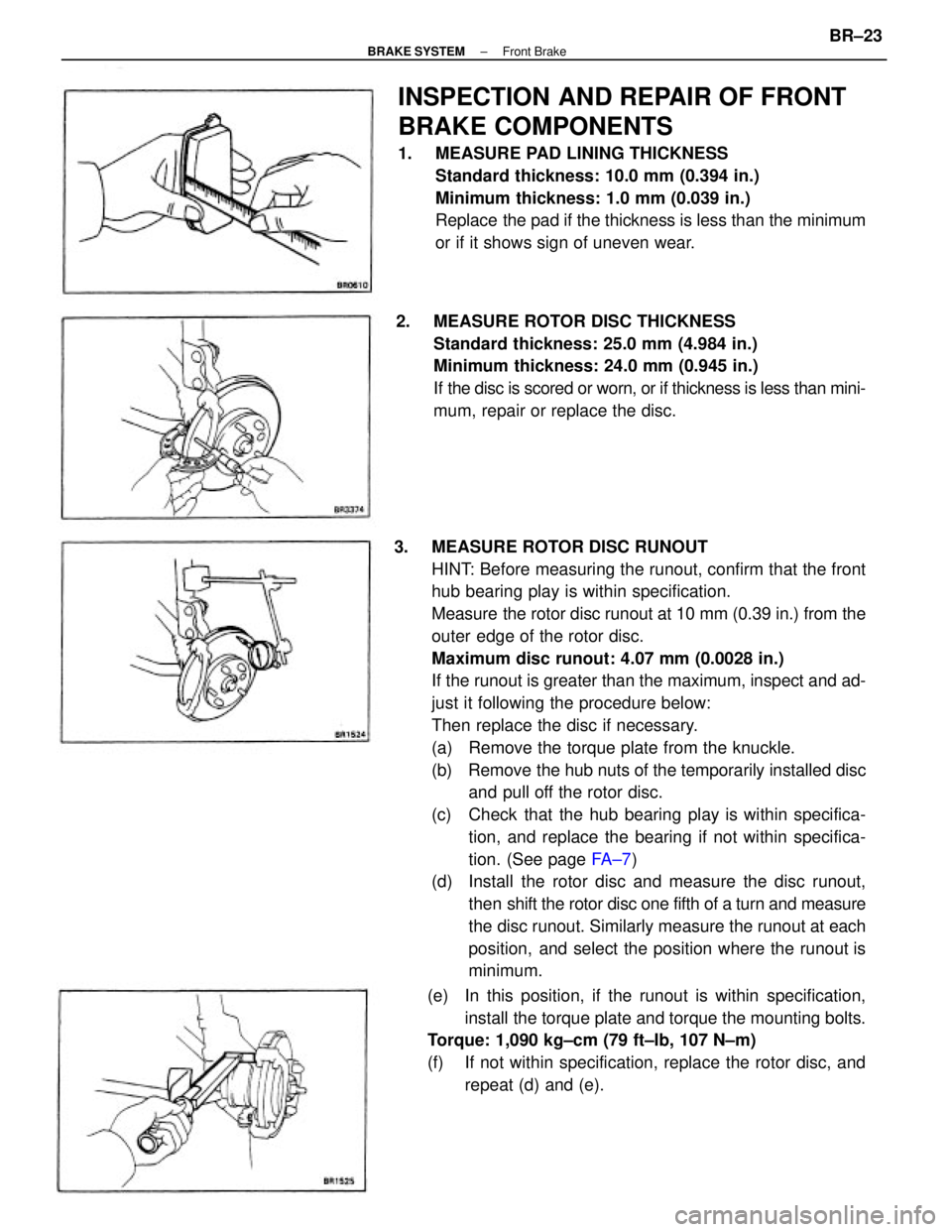
3. MEASURE ROTOR DISC RUNOUT
HINT: Before measuring the runout, confirm that the front
hub bearing play is within specification.
Measure the rotor disc runout at 10 mm (0.39 in.) from the
outer edge of the rotor disc.
Maximum disc runout: 4.07 mm (0.0028 in.)
If the runout is greater than the maximum, inspect and ad-
just it following the procedure below:
Then replace the disc if necessary.
(a) Remove the torque plate from the knuckle.
(b) Remove the hub nuts of the temporarily installed disc
and pull off the rotor disc.
(c) Check that the hub bearing play is within specifica-
tion, and replace the bearing if not within specifica-
tion. (See page FA ± 7)
(d) Install the rotor disc and measure the disc runout,
then shift the rotor disc one fifth of a turn and measure
the disc runout. Similarly measure the runout at each
position, and select the position where the runout is
minimum.
INSPECTION AND REPAIR OF FRONT
BRAKE COMPONENTS
1. MEASURE PAD LINING THICKNESS
Standard thickness: 10.0 mm (0.394 in.)
Minimum thickness: 1.0 mm (0.039 in.)
Replace the pad if the thickness is less than the minimum
or if it shows sign of uneven wear.
2. MEASURE ROTOR DISC THICKNESS
Standard thickness: 25.0 mm (4.984 in.)
Minimum thickness: 24.0 mm (0.945 in.)
If the disc is scored or worn, or if thickness is less than mini-
mum, repair or replace the disc.
(e) In this position, if the runout is within specification,
install the torque plate and torque the mounting bolts.
Torque: 1,090 kg±cm (79 ft±Ib, 107 N±m)
(f) If not within specification, replace the rotor disc, and
repeat (d) and (e).
± BRAKE SYSTEMFront BrakeBR±23
Page 875 of 2389
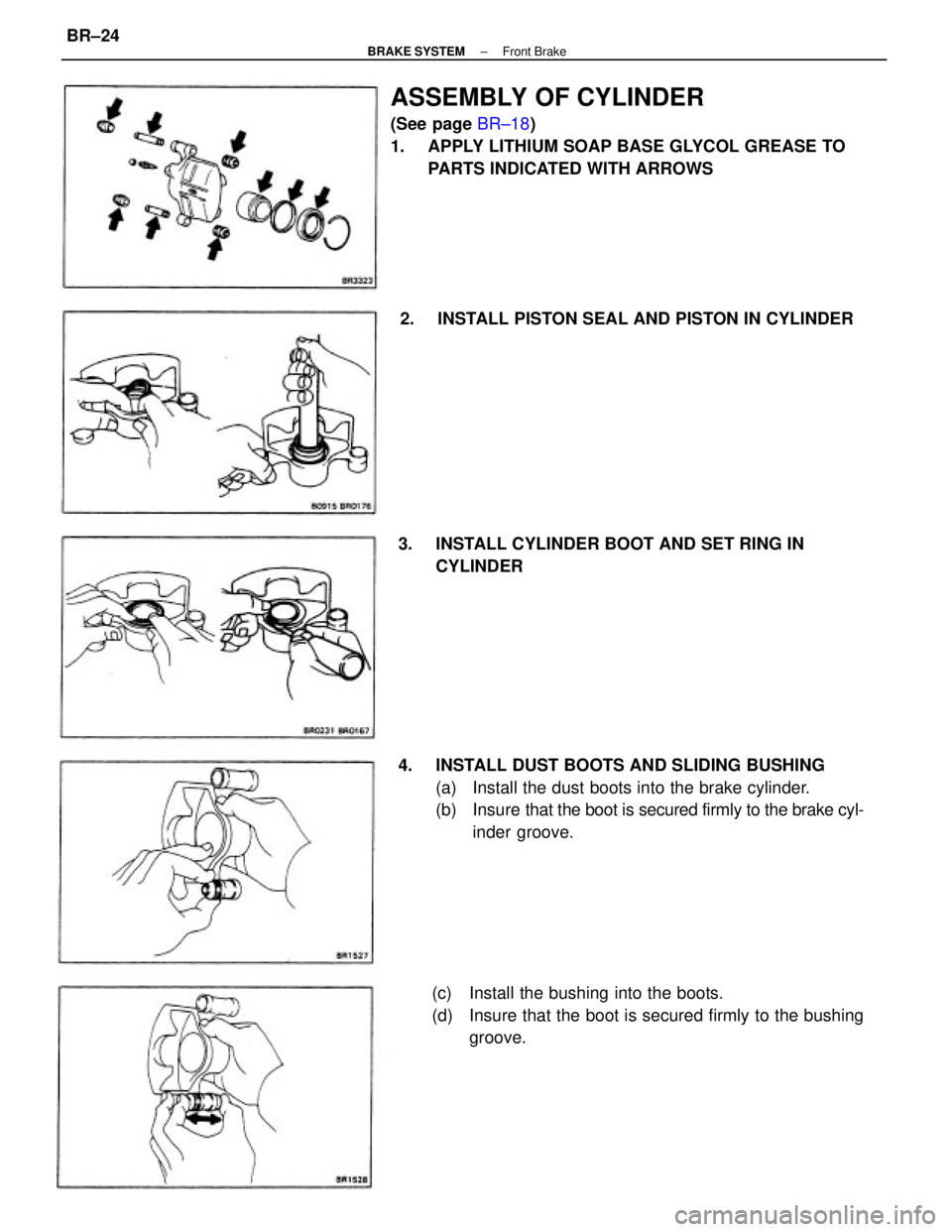
ASSEMBLY OF CYLINDER
(See page BR±18)
1. APPLY LITHIUM SOAP BASE GLYCOL GREASE TO
PARTS INDICATED WITH ARROWS
4. INSTALL DUST BOOTS AND SLIDING BUSHING
(a) Install the dust boots into the brake cylinder.
(b) Insure that the boot is secured firmly to the brake cyl-
inder groove.
(c) Install the bushing into the boots.
(d) Insure that the boot is secured firmly to the bushing
groove. 3. INSTALL CYLINDER BOOT AND SET RING IN
CYLINDER 2. INSTALL PISTON SEAL AND PISTON IN CYLINDER
± BRAKE SYSTEMFront BrakeBR±24
Page 876 of 2389
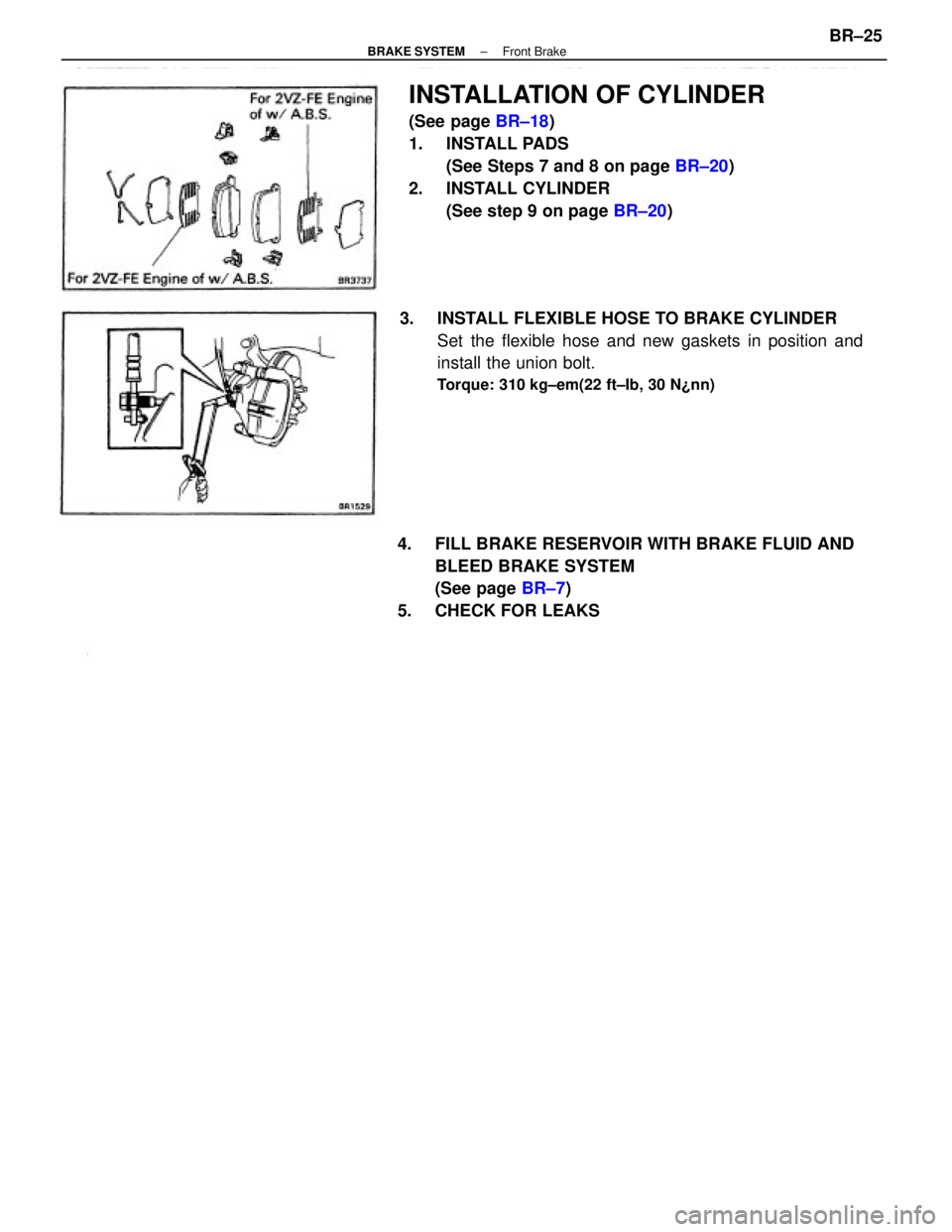
INSTALLATION OF CYLINDER
(See page BR±18)
1. INSTALL PADS
(See Steps 7 and 8 on page BR±20)
2. INSTALL CYLINDER
(See step 9 on page BR±20)
3. INSTALL FLEXIBLE HOSE TO BRAKE CYLINDER
Set the flexible hose and new gaskets in position and
install the union bolt.
Torque: 310 kg±em(22 ft±Ib, 30 N¿nn)
4. FILL BRAKE RESERVOIR WITH BRAKE FLUID AND
BLEED BRAKE SYSTEM
(See page BR±7)
5. CHECK FOR LEAKS
± BRAKE SYSTEMFront BrakeBR±25
Page 877 of 2389
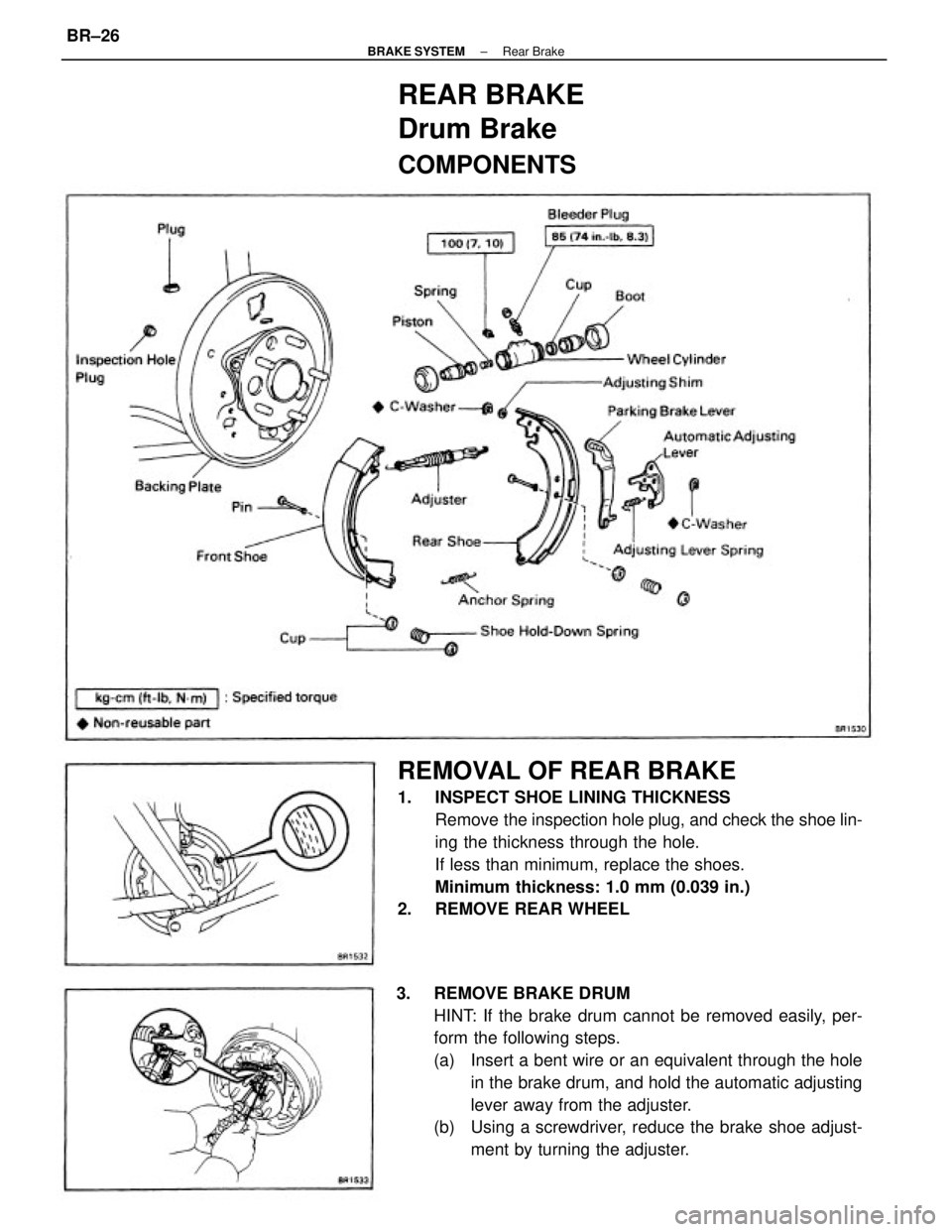
REMOVAL OF REAR BRAKE
1. INSPECT SHOE LINING THICKNESS
Remove the inspection hole plug, and check the shoe lin-
ing the thickness through the hole.
If less than minimum, replace the shoes.
Minimum thickness: 1.0 mm (0.039 in.)
2. REMOVE REAR WHEEL
3. REMOVE BRAKE DRUM
HINT: If the brake drum cannot be removed easily, per-
form the following steps.
(a) Insert a bent wire or an equivalent through the hole
in the brake drum, and hold the automatic adjusting
lever away from the adjuster.
(b) Using a screwdriver, reduce the brake shoe adjust-
ment by turning the adjuster.
REAR BRAKE
Drum Brake
COMPONENTS
± BRAKE SYSTEMRear BrakeBR±26
Page 878 of 2389
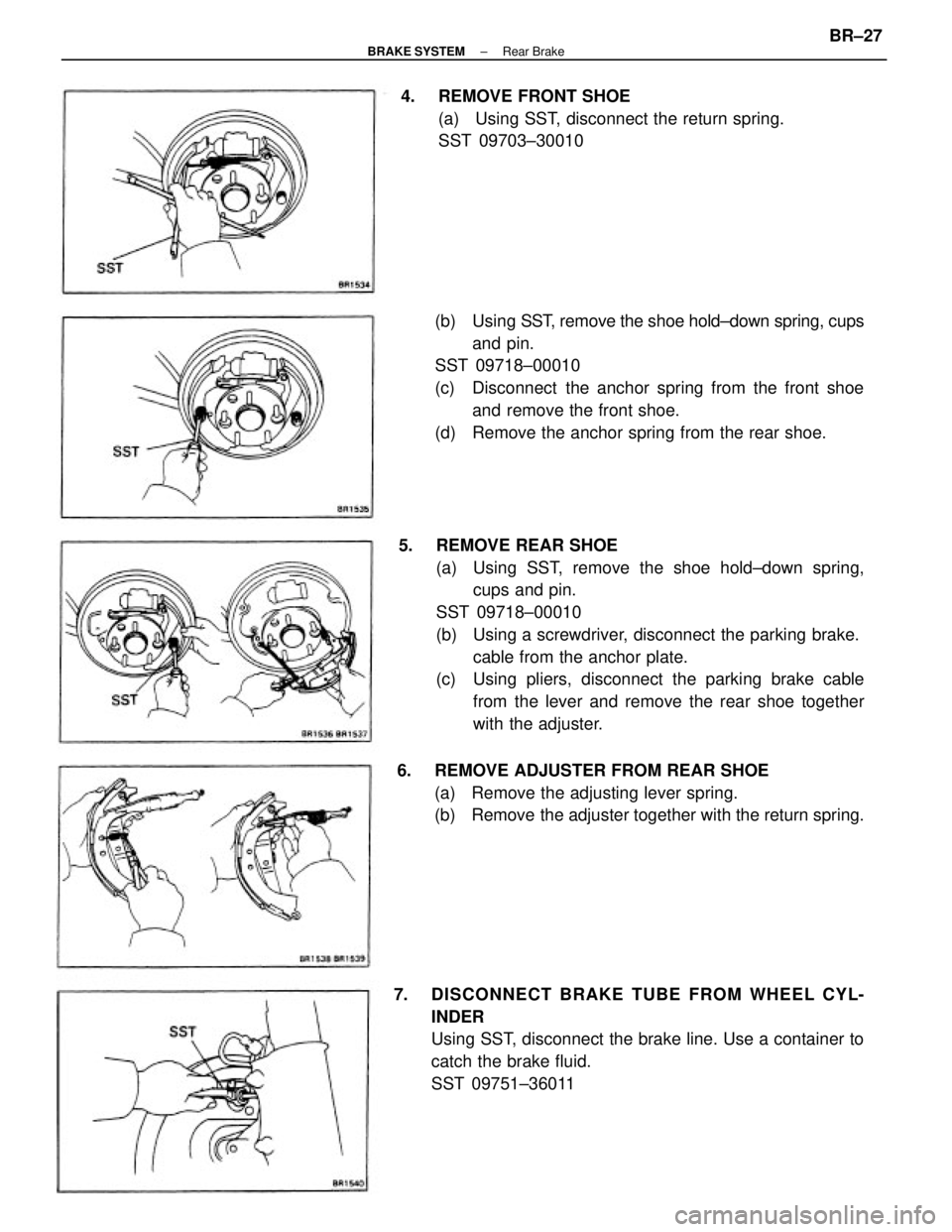
5. REMOVE REAR SHOE
(a) Using SST, remove the shoe hold±down spring,
cups and pin.
SST 09718±00010
(b) Using a screwdriver, disconnect the parking brake.
cable from the anchor plate.
(c) Using pliers, disconnect the parking brake cable
from the lever and remove the rear shoe together
with the adjuster. (b) Using SST, remove the shoe hold±down spring, cups
and pin.
SST 09718±00010
(c) Disconnect the anchor spring from the front shoe
and remove the front shoe.
(d) Remove the anchor spring from the rear shoe.
7. DISCONNECT BRAKE TUBE FROM WHEEL CYL-
INDER
Using SST, disconnect the brake line. Use a container to
catch the brake fluid.
SST 09751±36011 6. REMOVE ADJUSTER FROM REAR SHOE
(a) Remove the adjusting lever spring.
(b) Remove the adjuster together with the return spring. 4. REMOVE FRONT SHOE
(a) Using SST, disconnect the return spring.
SST 09703±30010
± BRAKE SYSTEMRear BrakeBR±27
Page 879 of 2389
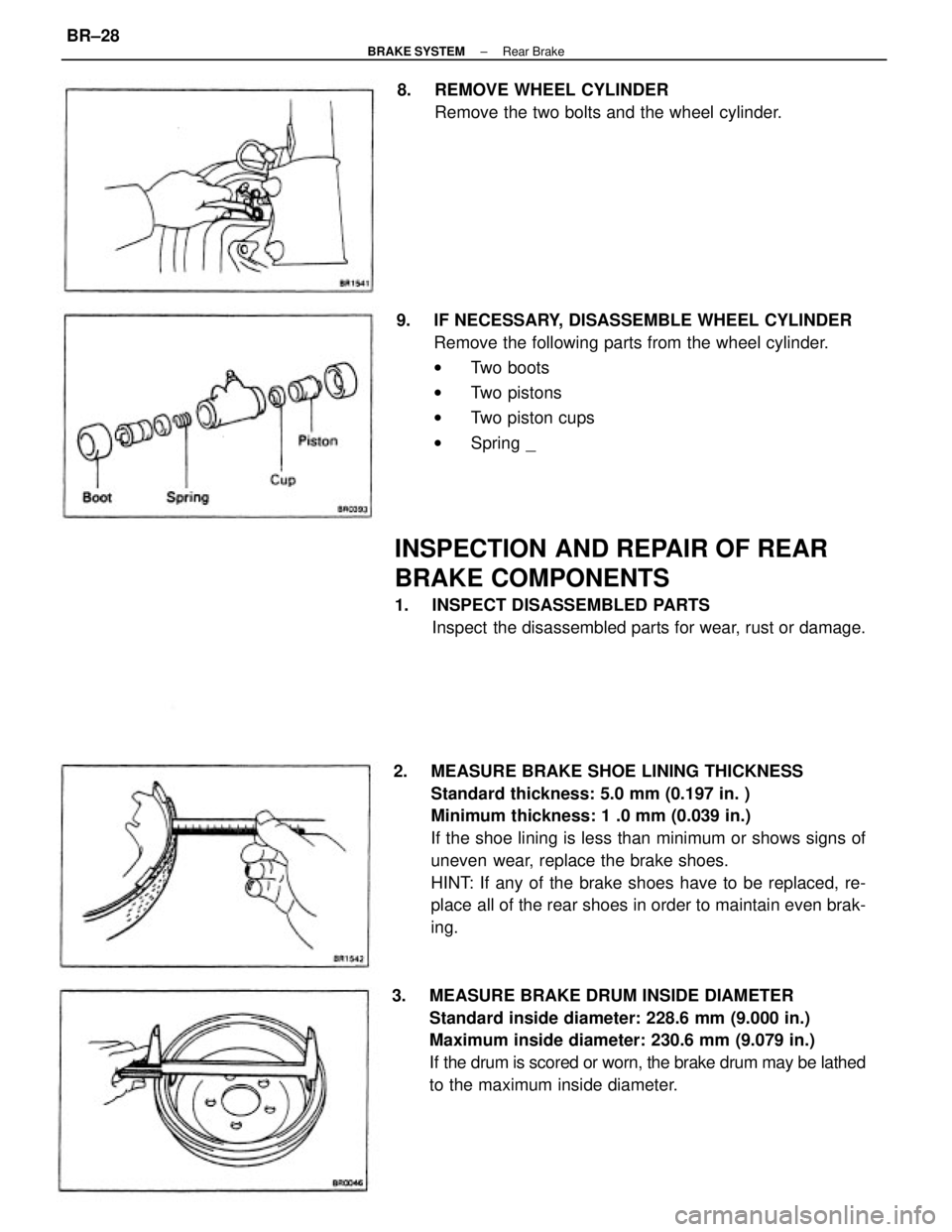
2. MEASURE BRAKE SHOE LINING THICKNESS
Standard thickness: 5.0 mm (0.197 in. )
Minimum thickness: 1 .0 mm (0.039 in.)
If the shoe lining is less than minimum or shows signs of
uneven wear, replace the brake shoes.
HINT: If any of the brake shoes have to be replaced, re-
place all of the rear shoes in order to maintain even brak-
ing. 9. IF NECESSARY, DISASSEMBLE WHEEL CYLINDER
Remove the following parts from the wheel cylinder.
wTwo boots
wTwo pistons
wTwo piston cups
wSpring _
3. MEASURE BRAKE DRUM INSIDE DIAMETER
Standard inside diameter: 228.6 mm (9.000 in.)
Maximum inside diameter: 230.6 mm (9.079 in.)
If the drum is scored or worn, the brake drum may be lathed
to the maximum inside diameter.
INSPECTION AND REPAIR OF REAR
BRAKE COMPONENTS
1. INSPECT DISASSEMBLED PARTS
Inspect the disassembled parts for wear, rust or damage. 8. REMOVE WHEEL CYLINDER
Remove the two bolts and the wheel cylinder.
± BRAKE SYSTEMRear BrakeBR±28
Page 880 of 2389
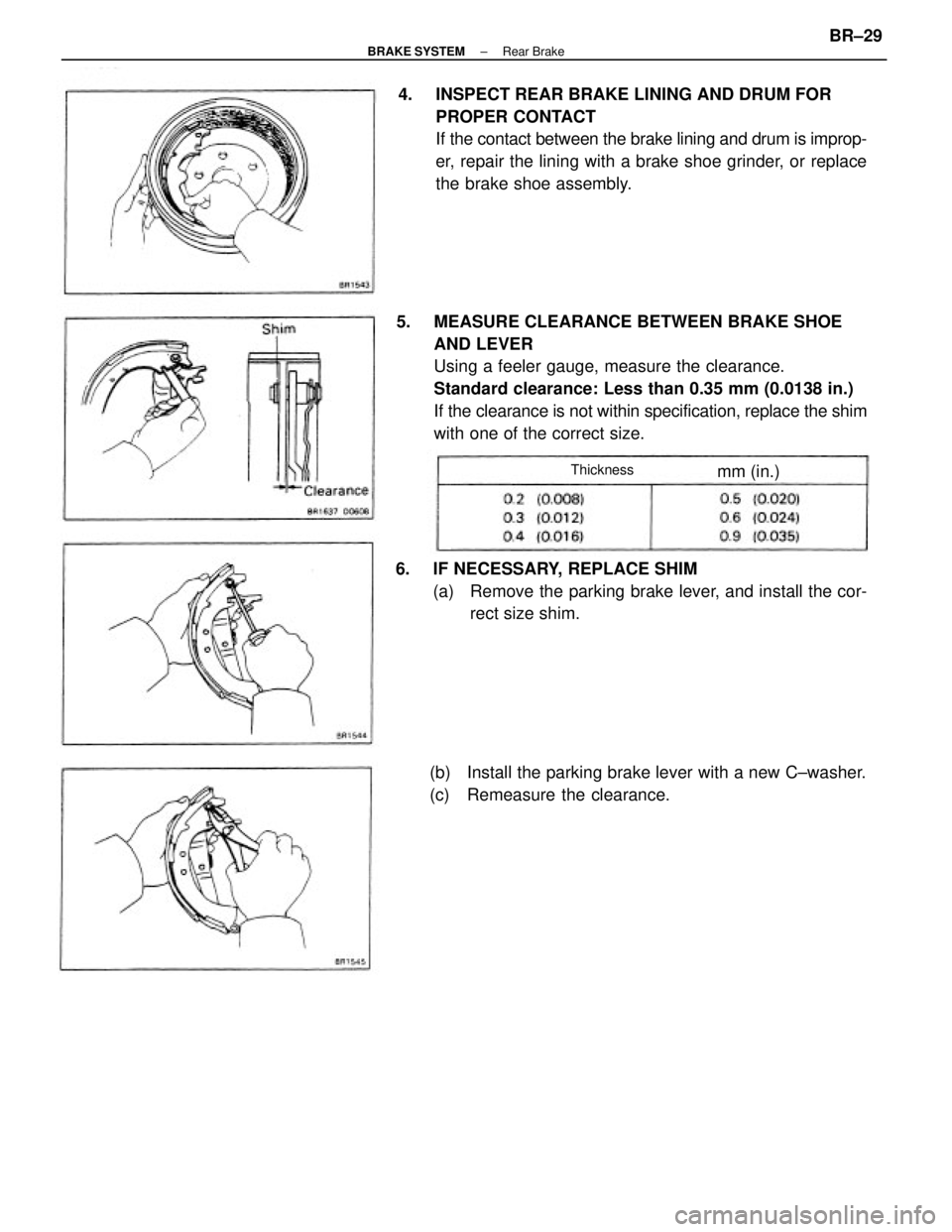
5. MEASURE CLEARANCE BETWEEN BRAKE SHOE
AND LEVER
Using a feeler gauge, measure the clearance.
Standard clearance: Less than 0.35 mm (0.0138 in.)
If the clearance is not within specification, replace the shim
with one of the correct size. 4. INSPECT REAR BRAKE LINING AND DRUM FOR
PROPER CONTACT
If the contact between the brake lining and drum is improp-
er, repair the lining with a brake shoe grinder, or replace
the brake shoe assembly.
6. IF NECESSARY, REPLACE SHIM
(a) Remove the parking brake lever, and install the cor-
rect size shim.
(b) Install the parking brake lever with a new C±washer.
(c) Remeasure the clearance.
Thicknessmm (in.)
± BRAKE SYSTEMRear BrakeBR±29